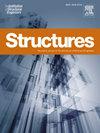Influence of web holes on cold-formed steel beams: Experimental and numerical analysis
IF 4.3
2区 工程技术
Q1 ENGINEERING, CIVIL
引用次数: 0
Abstract
This research investigates the impact of web holes on the bending behaviour of beams, presenting both experimental and numerical investigations. It also introduces a new design equation. The experimental study involved subjecting 11 beams with and without holes to a four-point bending test, considering variables such as hole dimensions, number of holes, and spacing. The moment carrying capacity and failure modes of the beams with and without holes were thoroughly examined. It was established that hole dimensions play a crucial role in both the moment carrying capacity and failure mode of the beams. The numerical study developed 106 finite element models to validate the experimental data and explore various parameters. The validation models demonstrated good agreement with the experimental results. The parametric study analyzed variables such as hole shape, size, spacing, location, and section thickness. It was found that the moment carrying capacity decreased when the hole height/web height ratio exceeded 0.67, and the web height/thickness ratio increased. The numerical study results were compared with the local buckling strength equations proposed by AISI S100, AS/NZS 4600, and the design equation in the literature. The comparison revealed the inadequacy of these approaches as hole dimensions increased. Consequently, a new design equation for local buckling strength calculations was proposed and compared with the results. The proposed equation yielded more consistent results, especially for members with larger hole sizes.
腹板孔对冷弯型钢梁的影响:试验与数值分析
本研究探讨了腹板孔对梁的弯曲行为的影响,提出了实验和数值研究。并引入了一个新的设计方程。实验研究包括对11根带孔和不带孔的梁进行四点弯曲测试,考虑诸如孔尺寸、孔数量和间距等变量。研究了带孔和不带孔梁的弯矩承载力和破坏模式。结果表明,孔尺寸对梁的弯矩承载能力和破坏模式都有重要影响。数值研究建立了106个有限元模型来验证实验数据并探索各种参数。验证模型与实验结果吻合较好。参数化研究分析了孔的形状、尺寸、间距、位置和截面厚度等变量。当孔高/腹板高比大于0.67时,承载弯矩能力减小,腹板高/厚比增大。数值研究结果与AISI S100、AS/NZS 4600提出的局部屈曲强度方程以及文献中的设计方程进行了比较。比较表明,随着孔尺寸的增加,这些方法的不足之处。在此基础上,提出了一种新的局部屈曲强度计算公式,并与计算结果进行了比较。提出的方程得到了更加一致的结果,特别是对于孔尺寸较大的构件。
本文章由计算机程序翻译,如有差异,请以英文原文为准。
求助全文
约1分钟内获得全文
求助全文
来源期刊

Structures
Engineering-Architecture
CiteScore
5.70
自引率
17.10%
发文量
1187
期刊介绍:
Structures aims to publish internationally-leading research across the full breadth of structural engineering. Papers for Structures are particularly welcome in which high-quality research will benefit from wide readership of academics and practitioners such that not only high citation rates but also tangible industrial-related pathways to impact are achieved.
 求助内容:
求助内容: 应助结果提醒方式:
应助结果提醒方式:


